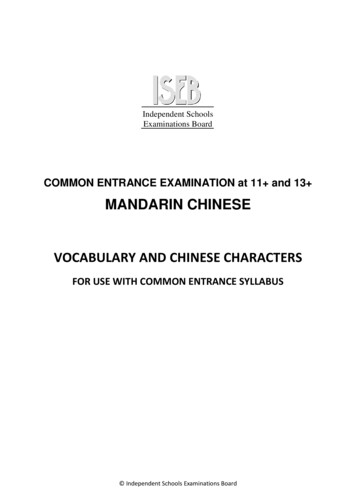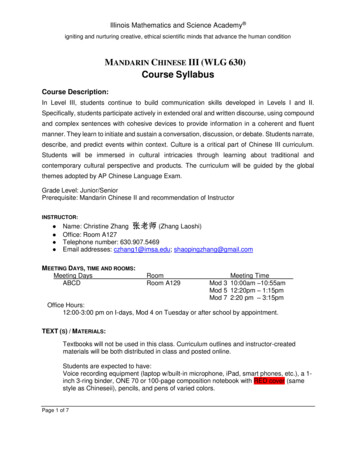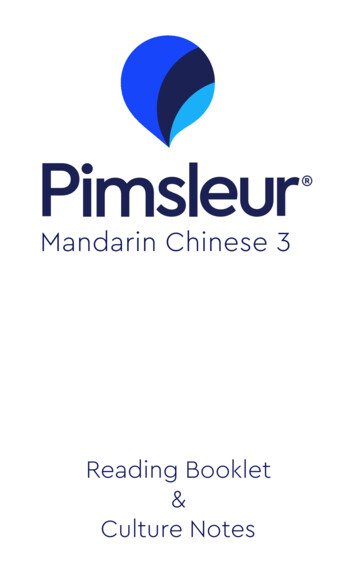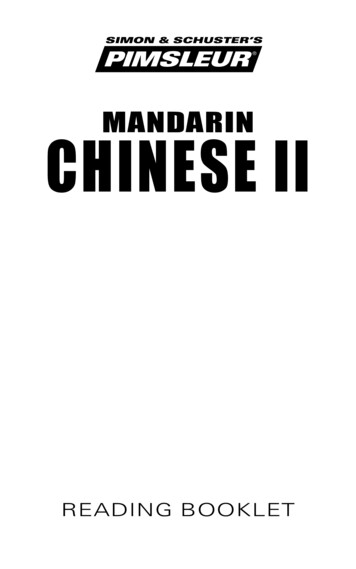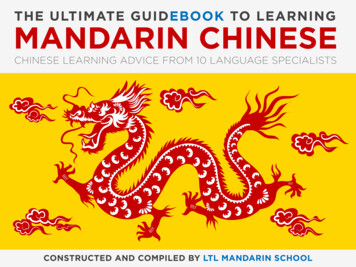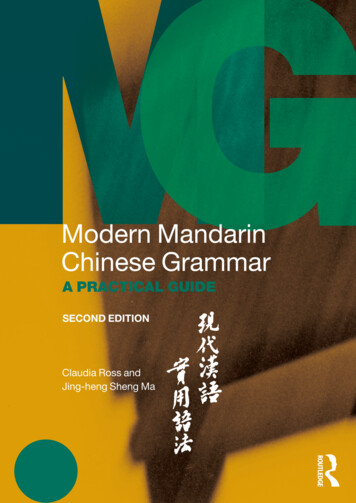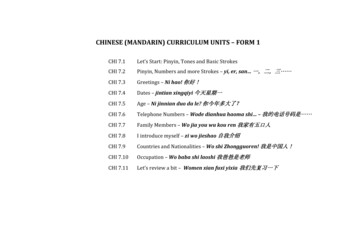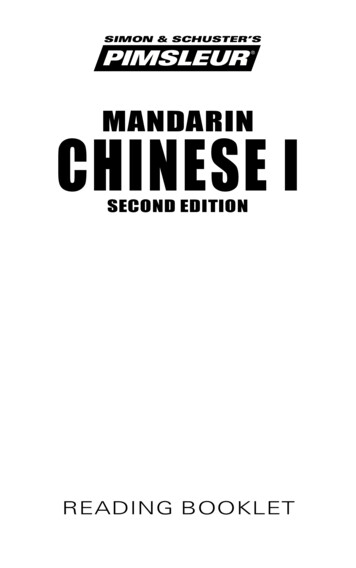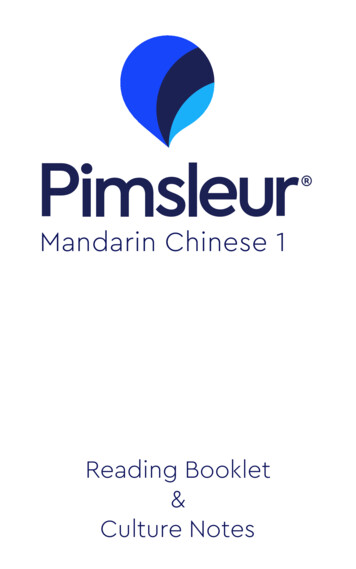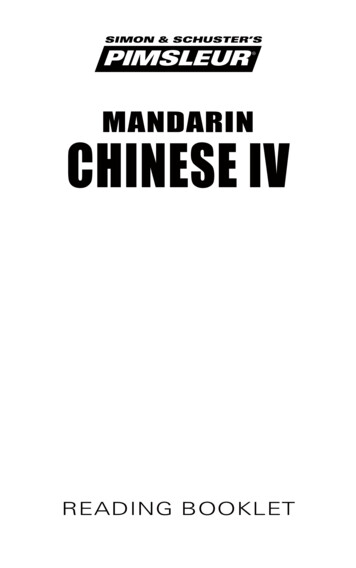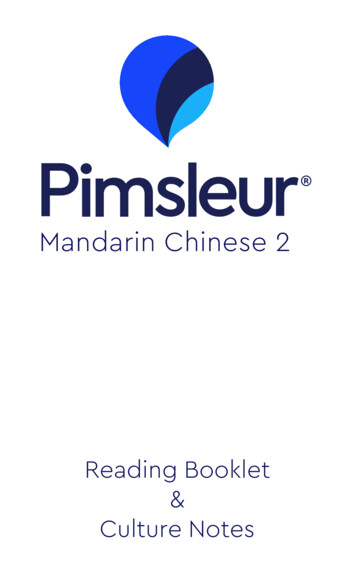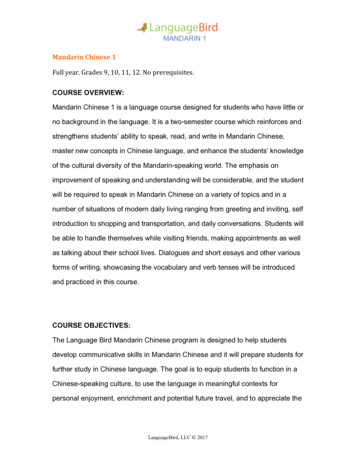
Transcription
MANDARIN 1Mandarin Chinese 1Full year. Grades 9, 10, 11, 12. No prerequisites.COURSE OVERVIEW:Mandarin Chinese 1 is a language course designed for students who have little orno background in the language. It is a two-semester course which reinforces andstrengthens students’ ability to speak, read, and write in Mandarin Chinese,master new concepts in Chinese language, and enhance the students’ knowledgeof the cultural diversity of the Mandarin-speaking world. The emphasis onimprovement of speaking and understanding will be considerable, and the studentwill be required to speak in Mandarin Chinese on a variety of topics and in anumber of situations of modern daily living ranging from greeting and inviting, selfintroduction to shopping and transportation, and daily conversations. Students willbe able to handle themselves while visiting friends, making appointments as wellas talking about their school lives. Dialogues and short essays and other variousforms of writing, showcasing the vocabulary and verb tenses will be introducedand practiced in this course.COURSE OBJECTIVES:The Language Bird Mandarin Chinese program is designed to help studentsdevelop communicative skills in Mandarin Chinese and it will prepare students forfurther study in Chinese language. The goal is to equip students to function in aChinese-speaking culture, to use the language in meaningful contexts forpersonal enjoyment, enrichment and potential future travel, and to appreciate theLanguageBird, LLC 2017
MANDARIN 1role of Chinese cultures in a global context through conversing regularly with anative speaker.The goal of Mandarin Chinese 1 is to lay a good foundation for Chinese for furtherstudy, and to strive for an all-round development of communicative competence inlistening, speaking, reading and writing in modern Chinese.COURSE DESCRIPTION:Students are introduced to the basic vocabulary, grammar and expressionsrelevant to real-life situations by engaging in a variety of activities that focus indeveloping listening, reading, speaking, and writing skills in Mandarin Chinese.During each session activities with the instructor may include: learning newvocabulary, auditory activities, online activities, writing experience and a focus onconversation practice with a native Mandarin speaker (goal is speaking inMandarin with their instructor 40% of the time). Students will begin to developtheir Mandarin proficiency through extensive interaction in the language. Inaddition, students will become more aware and gain knowledge of the culturallydiverse Mandarin-speaking world through a personal relationship with a nativespeaker and be able to develop insight into the nature of language and culture.COURSE METHODOLOGY:This is a conversation and inquiry-based course, which provides basic training ofpronunciation and tones, syntactic structures and usage, commonly usedvocabulary for day-to-day life, and character recognition and writing. This is also acourse where students discover and utilize their knowledge of the languagethrough suggested readings, assignments and direct interaction each sessionLanguageBird, LLC 2017
MANDARIN 1with their personal instructor. Each session is a full 50 minutes of one on onelistening and speaking and role-play situations in Mandarin. This experienceprovides students with the auditory experience they need to pronounce and readbasic Mandarin conversation and vocabulary.COURSE ASSIGNMENTS:The instructor facilitates the teaching process but the student is responsible foractively acquiring vocabulary and knowledge through suggested readings andactivities.The basic time commitment will be 2 hours for each lesson. A minimum of 2 hoursof study for each lesson outside of online class is recommended. There are alsowritten assignments for each lesson, which includes listening comprehension,reading comprehension, grammar exercises, translation, and characters writing,etc. Written assignments are submitted directly to the teacher by email.The student will also be assigned an ongoing project researching aMandarin-speaking country's culture, politics and geography. It is suggested thatthe student focus on the country that their instructor is from so that they can gainadditional information and insight from their personal connection.COURSE ON-GOING PROJECT ASSIGNMENTStudents will engage in ongoing research (in English) of a Mandarin-speakingcountry's culture, politics and geography. It is suggested that the student focus onthe country that their instructor is from so that they can gain additional informationand insight from their personal connection. The assignment is to be mailed toinstructor in the form of a PowerPoint presentation.LanguageBird, LLC 2017
MANDARIN 1The PowerPoint presentation must contain at least 8 slides detailing: culture(including arts and music), holidays, politics/political systems, geography,important or famous people from/in that country, main sources of development(exports/imports), religions and currency. Any additional information is alsowelcome. Students must include some Mandarin phrases they have learned aswell as ample pictures. The assignment must be turned in within a week after thestudent’s final session with the instructor.Primary Textbook: Integrated Chinese Level 1 Part 1* Integrated Chinese (Cheng & Tsui Company, 2015) is the textbook thatLanguage Bird instructors use to help guide lessons. The Integrated Chineseseries is an acclaimed, best-selling introductory course in Mandarin Chinese. Withits holistic, integrated focus on the four language skills of listening, speaking,reading, and writing, it teaches all the basics beginning and intermediate studentsneed to function in Chinese. The content of lessons is additionally directed bystudent interest and inquiry as topics naturally occur with their instructor whileconversing online. This helps students build a solid foundation and preparethemselves to face the real world.Integrated Chinese may be borrowed from a library, purchased online (new orused) or even borrowed from the student’s high school (the text is standard inmany high schools). Language Bird uses the most recent (2015) edition of the text.A digital version of the text is also available.LanguageBird, LLC 2017
MANDARIN 1This course is not completely text dependent. Instruction is completelydifferentiated based on student skill level and ability. Strategies may include:videos online, websites recommended by the teacher, movies or TV shows thatcan be viewed online, books/novels at the appropriate level, graphic organizerswhen needed. Instructors will be checking often for understanding, repeatingdirections, providing a rubric with detailed expectations and modelling is providedwhen needed for all students.COURSE TOPICSStudents will be able to:1. Exchange basic greetings withdifferent people11. Make and answer a phone call12. End a phone conversation without2. Asking about personalhurting the other person’s feelingsinformation13. Talk about their experience in3. Talk about familylearning languages4. Invite people to dinner, birthdayparty and other activities14. Express their modesty in terms oftheir abilities5. Suggest things to take to a15. Talk about their school livesget-together16. Write a brief letter and a simple6. Talking about hobbiesdiary in the proper format7. Set up plans with friends17. Ask for a different color and/or8. Welcome visitorssize of merchandise when they9. Introduce themselves, introduce aare shopping for Clothes andperson to anotherShoes.10. Set up appointments with others18. Talk about transportationLanguageBird, LLC 2017
MANDARIN 1UNITS:Unit 1: Greeting: Integrated Chinese, Level 1 Part 1, Pages 20-40Students will understand and use vocabulary and common phrases as related togreeting. Building upon prior lessons, this unit will help them to exchange basicgreetings with Chinese people, ask about their nationality, request a person’s lastname and full name, and provide their own. This is also the first time the personalpronoun and general questions will be explained to students, so they willdemonstrate how to use personal pronouns and how to use general questions toconform one’s identity.Assignments: Students will play a game called ‘Who is this?’ with theirinstructors using general questions and some nouns. They will be required toprepare a picture of a famous person, a five sentences describing the person.Instructors will guess who this is according to the given information. In thisprocess, students will learn how to describe a person and how to confirm others’identity.Unit 2: Family:Integrated Chinese, Level 1 Part 1, Pages 42-63Students will learn how to describe a family photo, how to introduce themselvesand the members of their family, how to talk with their Chinese friends aboutfamily members and relations among family, how to discuss work situations,different job positions, etc. This unit will also provide students with their firstexposure to measure words, and will enable them to understand the keyprinciples and rules governing the pairing of measure words and nouns.LanguageBird, LLC 2017
MANDARIN 1Assignments: Students should choose a famous family, draw a family tree, writea brief description of the family, and share their work in class.Unit 3: Dates and Time:Integrated Chinese, Level 1 Part 1, Pages 66-95Students will learn expressions relating to numbers, time, and dates, and willlearn how to discuss time-specific events such as holidays and deadlines. Theywill be introduced to various holiday interactions, including inviting other people toeat dinner or watch a movie during significant holidays, and will also gainknowledge of Chinese customs and cultural practices related to birthdaycelebrations. Students will be exposed to grammatical structures for alternativequestions, including relevant conjunctions and methods of answering thesequestions.Assignments: Students will be asked to make a “birthday plan” for a friend orrelative in which they arrange a full day of activities based on the person’s habits,preferences, daily schedule, etc. Students’ “birthday plans” should include clearand detailed information on the timing and nature of each activity.Unit 4: Hobbies:Integrated Chinese, Level 1 Part 1, Pages 98-120Students will learn how to talk about their interests, how to discuss personalhobbies and extra-curricular activities with other people, and will also gainvocabulary related specifically to athletics. Students will then learn how to makeweekend plans and discuss extra-curricular and weekend activities with friends.This unit will introduce students to some significant Chinese pastimes, and willenable students to narrate events which have occurred in the past.LanguageBird, LLC 2017
MANDARIN 1Assignments: Students will make an “activities calendar” by first searching tofind what extracurricular activities are offered by their school during the currentsemester, then selecting the activities that they are most interested in, and finallywriting them into a list detailing the content and scheduling of each activity. Theywill then discuss their calendar with their teacher.Unit 5: Visiting Friends:Integrated Chinese, Level 1 Part 1, Pages 122-144Students will learn how to exchange standard greetings and courtesies whenreceiving guests and when going to another person’s home as a guest. They willlearn polite expressions to use in guest-host contexts, and will be introduced toChinese cultural customs and protocols relating to guest and host conduct.Students will gain the language skills necessary to invite other people to their ownhome. This unit will also offer students a systematic introduction to tones andstress, including the role of tones and stress in determining meaning.Assignments: Students will generate a chart comparing Chinese and Westernguest-host culture, including such aspects as practices for inviting guests,gift-giving, proper arrival time for guests, etc. Students will then discuss theircomparison chart with their teacher, and will explore the possible cultural andsocietal reasons or contexts for the differences they have observed.Review Unit: Integrated Chinese, Level 1 Part 1, Pages 145-147That’s How the Chinese Say It: Students will review some functionalexpressions from lesson1-5 in terms of discussing some interesting topics withtheir teacher.LanguageBird, LLC 2017
MANDARIN 1Culture Highlights: Students will learn Chinese language and dialect, syllabicstructure, pronunciation of modern standard Chinese, Chinese names, Chinesemanner of counting age, Chinese food symbolizing longevity, Chinese way of“splitting ” the check; Chinese civilities upon meeting for the first time, andChinese tea culture.Assignments: Real-life task: students will discuss their family, work, or life with aChinese friend, or will invite their Chinese friend to come to their home as a guest.Students will then write a summary of what they learned from their interaction withtheir friend, including observations of cultural differences, and their own thoughtson these differences.Unit 6: Making Appointments:Integrated Chinese, Level 1 Part 1, Pages150-173Students will learn how to call their teachers to make an appointment, call a friendfor help, answer a phone call, initiate a phone conversation, and return a call.Students will gain a systematic understanding of prepositions and directionalcomplements, including the differences in usage of directional complements inChinese and English.Assignments: Students will draw a “buried treasure map,” using a building orlocal street as the setting, and will then write a set of directions to pair with themap, telling the reader how to find the treasure. Students will then compare theirdirections with those of their classmates, and determine who offered the clearestdirections, and what language they used to do so.Unit 7: Studying Chinese:Integrated Chinese, Level 1 Part 1, Pages 176-200LanguageBird, LLC
Mandarin Chinese 1 is a language course designed for students who have little or no background in the language. It is a two-semester course which reinforces and strengthens students’ ability to speak, read, and write in Mandarin Chinese, master new concepts in Chinese language, and enhance the students’ knowledge of the cultural diversity of the Mandarin-speaking world. The emphasis on .
